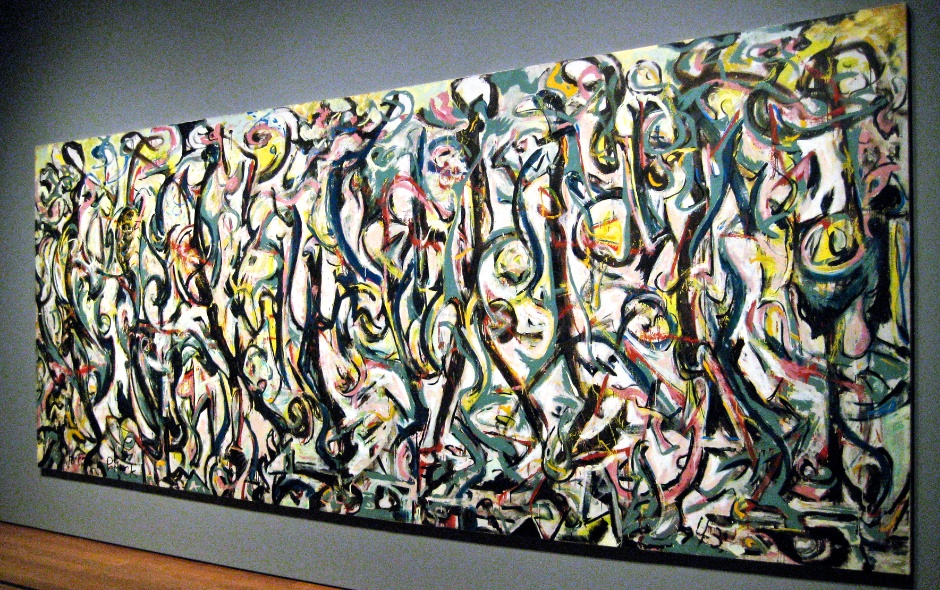 Jackson Pollock’s mural at the Getty Center. For more information, go to getty.edu/art/exhibitions/pollock/. Photograph by Roy Nicholson.
Jackson Pollock’s mural at the Getty Center. For more information, go to getty.edu/art/exhibitions/pollock/. Photograph by Roy Nicholson.
Mural Gets a Makeover
You might think that we already know all there is to know about Jackson Pollock’s life and work, but you’d be wrong. For example, before Pollock’s 1943 mural arrived at Getty Conservation Institute in Los Angeles, it had acquired a coating of varnish, as well as a heavy overlay of myth, both of which made it difficult to see the painting properly. Now, after more than 18 months of analysis and treatment, it has emerged from under its literal and figurative shrouds.
Anyone who doubts Pollock’s compositional and technical skills should study this canvas—at 8 x 20 feet, the largest he ever painted—on view at the Getty Center through June 1, after which it will travel. A tour de force of vibrant brushwork (this was before his signature pouring technique was fully developed), dynamic abstract rhythms and vivid colors, it signals his breakthrough after years of struggling to find his own direction. Like his hero, the Mexican muralist José Clemente Orozco, and his teacher, Thomas Hart Benton, Pollock wanted to paint big, bold pictures that could fill a room with energy. Thanks to his patron, Peggy Guggenheim, who commissioned the mural for the entrance hall of her Manhattan duplex, he was able to realize his ambition.
Pollock was unknown in 1943, and Peggy took a big risk in promoting him. His drinking problem and emotional fragility were red flags, but a talent that MoMA’s curator, James Johnson Sweeney, described as “volcanic” was also obvious. In addition to the mural commission, Peggy signed him up for solo shows at her avant-garde gallery, Art of This Century, and gave him financial support. She bet on his potential, and was rewarded with the credit for launching his career, as well as a superb collection of his paintings. When she moved to Italy after World War II she gave several of them to museums around the country, from Rhode Island to Seattle, and took the rest with her.
But the mural—which was made to be portable, since she was only renting the town house—was too big for her Venetian villa, and finding a home for it proved to be a challenge. There were no takers among the New York museums. Fortunately for the University of Iowa, the head of the art department learned that it was available and got it for the school. For years it hung in the art studio, but when the UI Museum of Art opened in 1969 it became the new building’s centerpiece.
Meanwhile the legend surrounding the mural grew and flourished. The story goes that after procrastinating for months, Pollock painted it in one furious burst of pent-up creative energy. He missed the deadline, so it wasn’t delivered until January 1944, two months after it was due. It was too big for the hallway, so Marcel Duchamp cut eight inches off one end. Turns out none of this is true. Doubts began to arise when the painting was shown at MoMA in Pollock’s 1998 retrospective, and it got its first major examination by conservators. There’s no evidence that it was cut down, and it certainly wasn’t painted in a single night.
The Conservation Institute’s painstaking analysis, discussed and illustrated on the Getty Center Web site, confirms that each layer of oil paint had to dry before the next one was applied, a process that takes days, if not weeks. Plus the finished painting needed drying time before it was unstretched and rolled, the only way to get it out Pollock’s studio door and into Peggy’s hallway. And a recently discovered letter from Peggy says it was in place by early November 1943, right on schedule. So much for the image of an irresponsible, impulsive artist splashing it out in a panic.
Looking at it now, without the 1973 varnish that dulled and flattened its surface, and cleverly re-stretched to disguise a slight sag caused by years on an inadequate support, it’s obvious that the mural is a thoughtfully conceived, methodically executed masterpiece. In addition to restoring its aesthetic glory, the Getty has done it a great service by unpacking its phony baggage.
Helen A. Harrison
Director, Pollock-Krasner House & Study Center
www.pkhouse.org
Reprint courtesy of the Sag Harbor Express.
_______________________________________________________________
